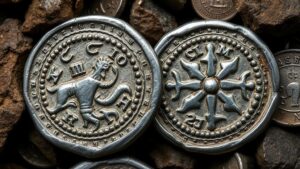Unearthing Rare Coins in Fields Cleared for Urban Development
Unearthing Rare Coins in Fields Cleared for Urban Development
The practice of unearthing rare coins in fields that have been cleared for urban development is a fascinating intersection of archaeology, history, and economic value. As urban centers expand, previously untouched areas become sites of extensive exploration, often revealing forgotten treasures. This article explores the methodologies used in locating these historical artifacts, the significance of rare coin findings, and some notable case studies.
The Process of Unearthing Coins
Uncovering rare coins begins with strategic planning and a thorough understanding of historical contexts. Several steps are integral to the process:
- Site Research: Before any digging, researchers conduct historical research to ascertain the likelihood of finding coins in a particular area. This includes studying historical maps, documents, and oral histories.
- Higher Ground and Rivers: Rare coins are often found in locations that were once near older trade routes, rivers, or elevated areas where people used to gather.
- Soil Testing and Surveys: Soil sampling and electromagnetic surveys can reveal buried metal objects. These surveys help pinpoint areas worth investigating further.
- Excavation Techniques: Once a promising area is identified, archaeologists and metal detectors meticulously excavate the site. This step requires specialized tools and techniques to avoid damaging the artifacts.
The use of technology has revolutionized how treasure hunters and archaeologists approach sites. For example, Ground Penetrating Radar (GPR) allows for non-invasive analysis of subsurface structures and has increased the chances of locating hidden coins before excavation begins.
Historical Significance of Rare Coins
Rare coins can serve as tangible links to the past, revealing valuable information about the economic, cultural, and political landscapes of bygone eras. These coins may be tied to specific events, regions, or figures in history. For example, coins from the Roman Empire offer insight into trade practices and local governance during its zenith.
In urban development, unearthing these coins can inform community understanding of historical demographics and social structures. For example, the finding of a series of Victorian-era coins during an urban redevelopment project in London not only quantified the wealth distribution of that period but also generated interest in preserving certain historical sites.
Case Studies of Urban Development Coin Discoveries
Numerous case studies highlight the importance of rare coin discoveries in cleared urban development areas:
- The San Francisco Mint: During renovations in the early 20th century, workers discovered a cache of gold coins from the California Gold Rush. This discovery sparked interest in the city’s historical wealth and inspired numerous conservation projects.
- The London Docklands: As the Docklands underwent significant changes in the late 20th century, hundreds of coins from the 18th and 19th centuries were found. Archaeologists used these to reconstruct aspects of daily life and trade practices in pre-industrial England.
These discoveries not only provide historical context but also raise awareness about the importance of preserving local heritage during new development projects.
Challenges and Ethical Considerations
While unearthing rare coins can yield invaluable insights, it is not without challenges. Ethical considerations arise regarding the ownership and preservation of artifacts, especially in urban areas undergoing rapid development.
- Ownership Disputes: Finding a valuable coin can lead to disputes over who owns it–private individuals, landowners, or the state. Each case can have ramifications for local laws and regulations regarding treasure hunting.
- Impact on Archaeological Integrity: Rapid development can compromise archaeological sites. efore, there is a call for balanced policies that respect both urban growth and heritage conservation.
Engaging with local communities and implementing regulations can help mitigate these challenges. Public archaeology initiatives can educate the public on the historical significance of their regional artifacts and involve them in preservation efforts.
Actionable Takeaways
For individuals and organizations interested in engaging in treasure hunting or archaeological exploration in urban development areas, these actionable insights may prove invaluable:
- Conduct Thorough Research: Before embarking on any project, ensure a comprehensive understanding of the sites history and previous findings.
- Collaborate with Professionals: Partner with archaeologists and historians to enhance credibility and ensure responsible excavation practices.
- Document Findings: Properly document and preserve any discovered artifacts to contribute to the collective knowledge of the areas history.
- Engage the Community: Involve local communities in the project to enhance public interest and support for the preservation of local heritage.
To wrap up, unearthing rare coins in fields cleared for urban development represents a unique opportunity to connect with the past. Through careful research and ethical practices, treasure hunting can contribute to our understanding of historical contexts while promoting heritage conservation.


